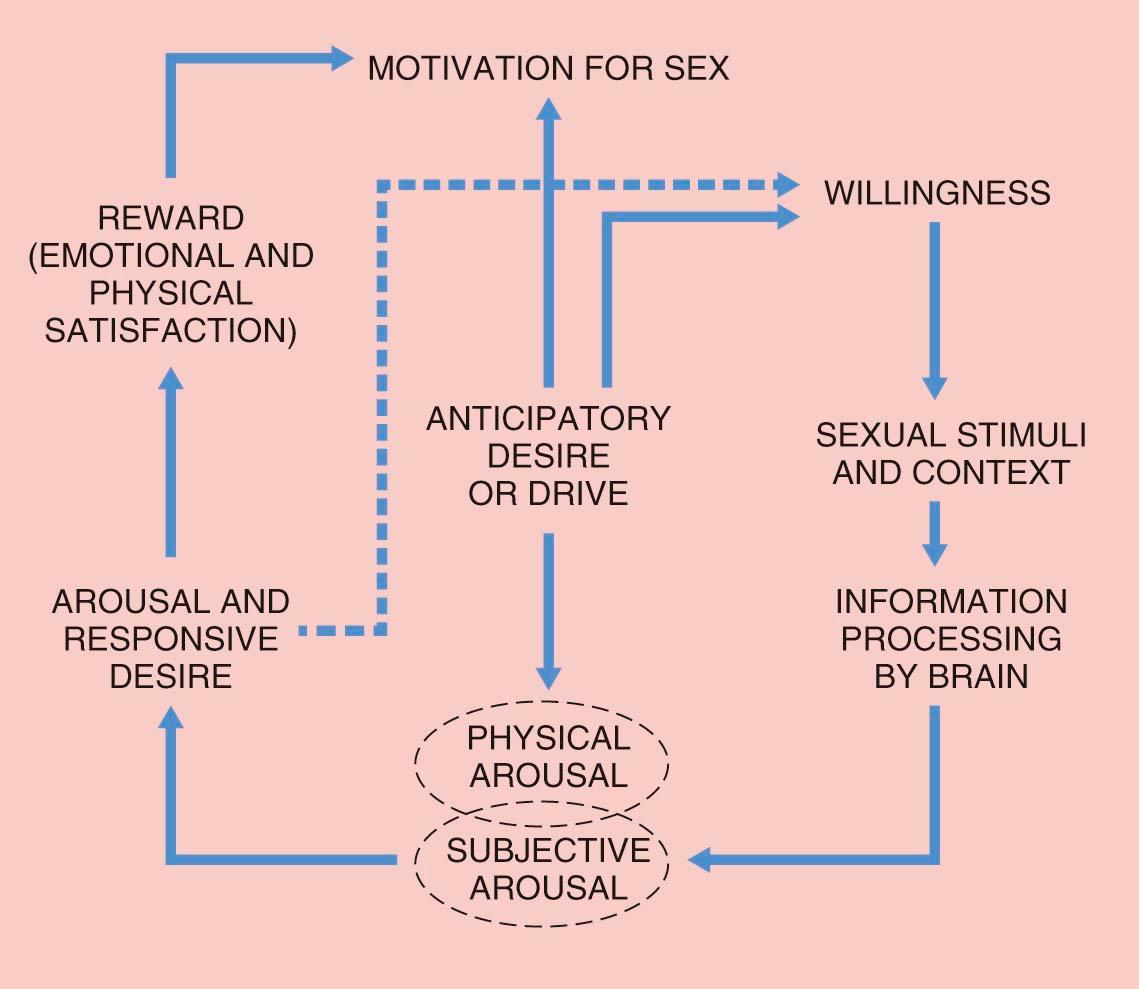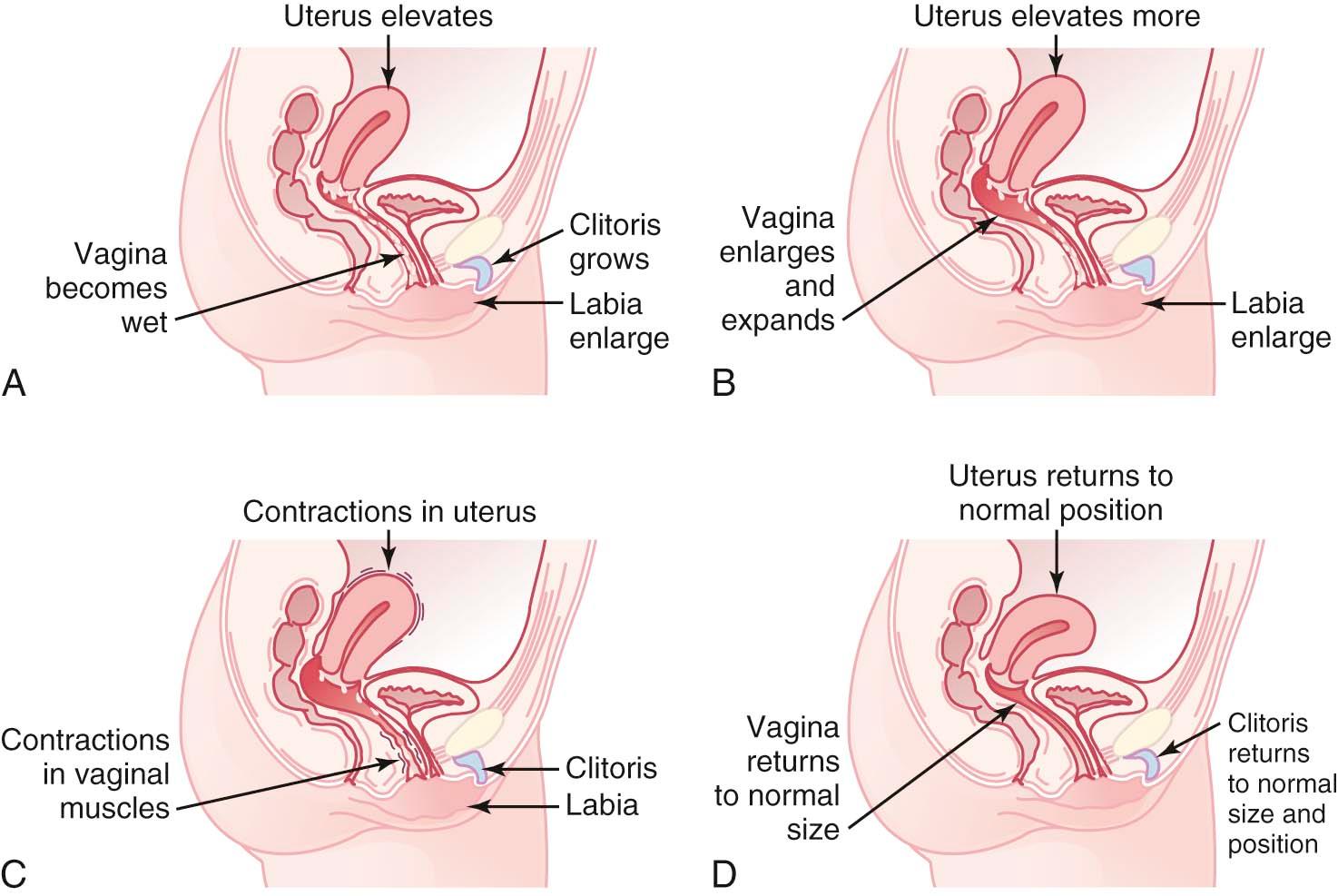Physical Address
304 North Cardinal St.
Dorchester Center, MA 02124
Sexuality and sexual expression are important aspects of human behavior. Recent liberalization of attitudes about sexuality and sexual expression has allowed the diversity of sexual behavior to be acknowledged. Although sexual expression is unlikely to begin before puberty, gender identity is expressed as early as 3 to 4 years of age. Gender identity disorder exists when children are unable to identify with their assigned gender.
Studies document that physicians are mostly unaware of the sexual concerns of their patients. One survey showed that a high percentage of postmenopausal women with dyspareunia had never discussed this condition with their physician. The obstetrician gynecologist is in a unique position to inquire about, diagnose, initiate treatment of, or refer for sexual concerns and dysfunction, because women frequently report that sexual function is affected by reproductive events.
Female and male physical sexual response cycles are similar, but they have some important differences. Most women need to experience a caring relationship and nongenital physical stimulation before satisfactory sexual arousal occurs. Men have a refractory phase during which no amount of stimulation will allow for an ejaculation and/or orgasm. Women may be capable of multiple orgasms, but an orgasm is not always necessary for sexual satisfaction.
An assessment of sexual functioning is an important part of the complete medical evaluation. Including questions about sexual orientation and difficulties with sexual relations can lead to important information about female and male sexual dysfunction and may reveal episodes of intimate partner and childhood sexual abuse.
Female sexual dysfunction may be primary (lifelong), secondary (acquired), or situational. The disorders include problems with desire, arousal, or orgasm, as well as pain during sexual activity. Referral to sex therapy specialists is appropriate for the first of those three disorders. The pain disorders frequently involve underlying gynecologic disease that the gynecologist can diagnose and treat. Lubricants and topical estrogen are often helpful. Investigations are underway to determine the safety and effectiveness of several androgenic preparations.
Sexuality refers to how individuals express themselves as sexual beings. Physically, sexuality encompasses sexual intercourse and other forms of sexual contact. Often patients may have medical concerns about their sexual feelings and behavior and how these activities may affect or be affected by disease. Obstetrician-gynecologists should be familiar with the physiology of the human sexual response and the types of sexual dysfunction that women may experience. Because female sexuality is most often expressed with another individual, and because that other individual is most often male, it is important for health care professionals who take care of women to know some basic aspects of the male sexual response and how it may differ from the female response. The sociology of human sexuality and sexual behavior, such as cultural, ethical, moral, religious, or legal aspects, are beyond the scope of this chapter.
Although sexuality and sexual expression rarely begin before puberty, gender identity is experienced much earlier, starting at about 3 to 4 years of age. Children who are unable to identify with their assigned birth gender have gender identity disorder (GID) and may develop transgender issues later in life. The diagnosis of GID can be made in an individual who has a strong and persistent cross-gender identity and a discomfort about the assigned gender.
During puberty, many teens begin exploring their bodies and experiencing sexual activity with others. Many teens, especially males, have early intercourse and are not well educated about contraception or the risks of pregnancy or sexually transmitted infections (STIs). Young girls often engage in intercourse because of feelings of love, whereas boys are usually driven by curiosity. It is especially important for physicians to discuss sexuality with teens and to educate them about contraception and STI prevention. Teens are often apprehensive about discussing these issues and may fear parental discovery. They are usually more receptive to open-ended questions.
The early reproductive years are often the time when sexuality is explored and reproduction or its prevention becomes a priority. Infertility may be an issue in this age group, and many emotions may be evoked in infertile patients, often leading to sexual problems.
With increasing age, and especially after menopause, the frequency of and satisfaction with intercourse may decline. Decreased estrogen production causes progressive vaginal atrophy, which in turn leads to decreased vaginal lubrication, dyspareunia, and more difficulty in achieving orgasm. The decreased estrogen also decreases the acidity of the vaginal secretions, predisposing the woman to vaginal infections.
In many older couples, the frequency of intercourse declines because of the male partner's inability to have an erection. Illnesses or increased use of medications may also affect sexual functioning. A better understanding of the causes, as well as more effective treatment for male erectile dysfunction, is changing the sexual behavior of many older individuals.
Human sexual expression is varied and often controversial. Health care professionals must be knowledgeable and nonjudgmental about healthy and legal sexual expression and lifestyles to facilitate open and comfortable communication.
Heterosexuals are individuals who engage in sexual activity with the opposite sex. Most individuals engage in heterosexual behavior, which is considered “normal.” Homosexuals are those who engage in sexual activities with members of the same sex. Men who are homosexual are referred to as gay, whereas homosexual women are referred to as gay or lesbian . Whereas gay men tend to engage in more physical relationships and may have multiple partners, lesbians are generally inclined to be monogamous.
The reported incidence of homosexuality ranges from 6-20% in men and 3-18% in women. Several theories on homosexuality have been proposed, including a genetic predisposition, the maternal use of prenatal hormones, and other environmental factors. A multifactorial cause is likely.
Many homosexuals feel a need to conceal their sexuality for fear of loss of family, friends, or jobs. Familiarity with homosexuals has been shown to decrease the prejudice, and recently many homosexuals have “come out,” revealing their sexual preference and expecting equal rights.
Bisexuals are those who engage in sexual activity with both men and women, either concomitantly or in different phases of their lives. The reported incidence of bisexuality is 1-7% of men and 1-2% of women. Many individuals briefly explore same-sex activity at some time in their lives but do not consider themselves bisexual.
Transgender or transsexual individuals are often confused with homosexuals. They have a strong belief starting in childhood that they were born into a body with the wrong sex. Most are heterosexual in reference to their identified gender (i.e., men who believe they are women are attracted to men), and few are homosexual. Children with ambiguous genitalia who are assigned a particular gender may later show regret about their assignment. Some experts recommend that these children be given a name that is appropriate to both genders to allow them to decide their gender for themselves later in life. Female-to-male transsexuals (FTM) are women who grow up as “tomboys” and often cross-dress. Male-to-female transsexuals (MTF) are men who grow up dressing as women. Transgender surgery is difficult to perform, especially for FTM transsexuals, and it is performed only in certain areas of the United States and the world.
The process of sexual response was fully described by Masters and Johnson in 1966 based upon extensive research. They delineated the female and male physical sexual response cycles. Although modifications have been published, the original Masters and Johnson version remains the classic description of human sexual response. The female cycle is divided into four phases, whereas in men five phases are described. Generally, clitoral tissue is the most sexually sensitive anatomic area for women. Most women need to experience a caring relationship and nongenital physical stimulation before satisfactory sexual arousal can occur. A more recent conceptualization of the female (and male) sexual response recognizes the likelihood that a willingness to become aroused must come first and is followed by the sensation of desire ( Figure 28-1 ). Box 28-1 lists the reproductive and life-cycle events that are known to affect a woman's sexual desire and response.

Healthy pregnancy
Complicated pregnancy precluding sexual intercourse and orgasm
Postpartum period
Miscarriage
Therapeutic abortion
Infertility
Perimenopause
Natural and premature menopause
The excitement phase starts for females with physical or psychologic stimulation and may last minutes or hours. There is a sex flush, accompanied by erection of the nipples and engorgement of the breasts. A sex flush is an erythematous morbilliform skin change over the chest, neck, and face that occurs to a noticeable degree in 75% of women. In addition, the uterus elevates and vaginal lubrication begins. The clitoris and labia enlarge, and the heart rate and blood pressure increase. Most muscles become tense ( Figure 28-2, A ).

During the plateau phase, the breasts continue to enlarge and the clitoris may elevate and retract under its hood. The Bartholin glands may secrete fluid near the vaginal opening, and there is tenting of the uterus to allow easier passage of sperm. The vagina and labia become more engorged, and blood pressure, heart rate, respiratory rate, and muscle tension increase (see Figure 28-2, B ).
During the orgasmic phase, there is release of sexual tension. This phase can occur without actual physical stimulation. It is concentrated in the clitoris, vagina, and uterus. There is contraction of vaginal, uterine, lower abdominal, and anal muscles, and usually there are 5 to 12 synchronized contractions 1 second apart. The first few contractions are the strongest and the closest together. Blood pressure, heart rate, and respiratory rate peak in this phase, and there is usually loss of voluntary muscle tone (e.g., most women curl their toes at orgasm). Women can have multiple orgasms before they enter the resolution phase (see Figure 28-2, C ).
Become a Clinical Tree membership for Full access and enjoy Unlimited articles
If you are a member. Log in here